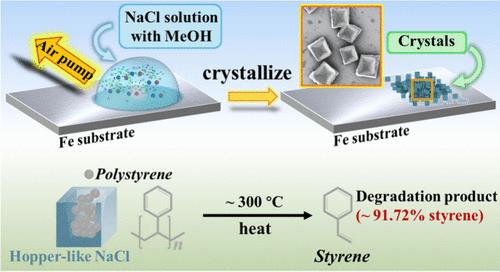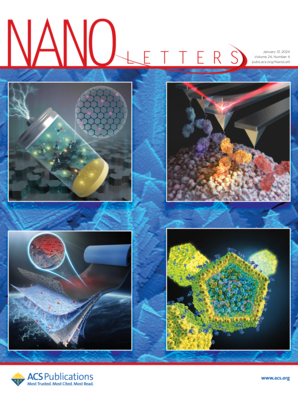Organic Molecules Induce the Formation of Hopper-Like NaCl Crystals under Rapid Evaporation As Microcatalytic Reactors To Facilitate Micro/Nanoplastic Degradation
IF 9.6
1区 材料科学
Q1 CHEMISTRY, MULTIDISCIPLINARY
引用次数: 0
Abstract
As representative examples of inorganic ionic crystals, NaCl and KCl usually form cubes during the natural evaporation process. Herein, we report the hopper-like NaCl and KCl crystals formed on the iron surface under rapid vacuum evaporation aided by organic molecules. Theoretical and experimental results indicate that it is attributed to the organic molecules alternating adsorption between {100} and {110} surfaces instead of adsorbing a single surface, as well as the fast crystal growth rate. Following this law, we found hopper-like crystals formed under natural evaporation conditions in salt lake crystals as well as synthesized kilogram-class hopper-like crystals. Interestingly, the hopper-like crystals can act as microcatalytic reactors to efficiently facilitate micro/nanoplastic degradation with ∼91.72% styrene yield, highly decreasing the degradation temperature from ∼400 to ∼275 °C. These findings provide an understanding of the growth mechanism of various crystals and a friendly environmental, low-carbon, and economical microcatalytic reactor for efficient micro/nanoplastic degradation.

求助全文
约1分钟内获得全文
求助全文
来源期刊

Nano Letters
工程技术-材料科学:综合
CiteScore
16.80
自引率
2.80%
发文量
1182
审稿时长
1.4 months
期刊介绍:
Nano Letters serves as a dynamic platform for promptly disseminating original results in fundamental, applied, and emerging research across all facets of nanoscience and nanotechnology. A pivotal criterion for inclusion within Nano Letters is the convergence of at least two different areas or disciplines, ensuring a rich interdisciplinary scope. The journal is dedicated to fostering exploration in diverse areas, including:
- Experimental and theoretical findings on physical, chemical, and biological phenomena at the nanoscale
- Synthesis, characterization, and processing of organic, inorganic, polymer, and hybrid nanomaterials through physical, chemical, and biological methodologies
- Modeling and simulation of synthetic, assembly, and interaction processes
- Realization of integrated nanostructures and nano-engineered devices exhibiting advanced performance
- Applications of nanoscale materials in living and environmental systems
Nano Letters is committed to advancing and showcasing groundbreaking research that intersects various domains, fostering innovation and collaboration in the ever-evolving field of nanoscience and nanotechnology.
 求助内容:
求助内容: 应助结果提醒方式:
应助结果提醒方式:


